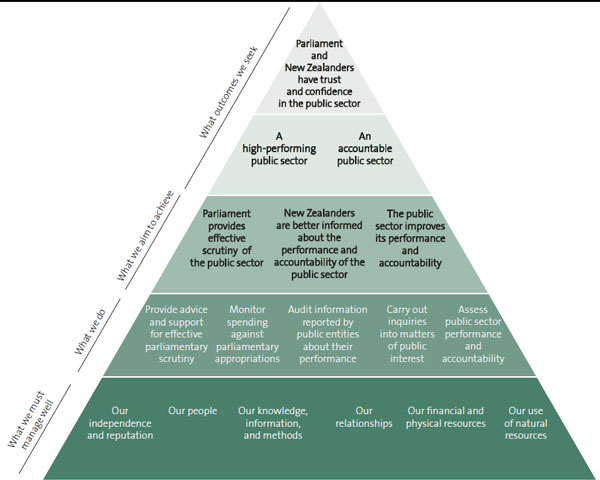Part 1: About us
The Controller and Auditor-General (the Auditor-General) is the auditor of every public organisation in New Zealand. Each year, the Auditor-General audits about 3500 public organisations that are required to publicly report, many of which are funded by rates or taxes.
This includes, for example, every government department, every district health board, every state school, every university and polytechnic, and every local authority.
Collectively, public organisations are managing the spending of more than $150 billion of public money each year.
The Auditor-General's work is carried out by nearly 400 staff in two business units – the Office of the Auditor-General (OAG) and Audit New Zealand – supported by shared staff in a Corporate Services Team (CST).
We also contract auditors from private sector auditing firms to carry out some audits on the Auditor-General's behalf. We call this whole organisation "the Office".
Our purpose
Improving trust, promoting value.
Our strategic risks
Our strategic risks are:
- loss of independence;
- audit failure;
- loss of capability; and
- loss of reputation.
We manage these risks through the processes that support the work we do.
In addition, our Audit and Risk Committee provides further insight and advice to help us identify and manage risk. The Committee's report for the year ended 30 June 2019 is included as Appendix 1.
What we stand for
- People matter;
- Our independence is critical;
- We act with integrity and courage;
- We're here to make a difference.
Our performance framework
Our performance framework below summarises the outcomes we seek, what we aim to achieve, what we do (the services we provide), and the resources we must manage well.
To improve our own reporting and accountability, we recently reviewed all the performance indicators we use for externally reporting on the outcomes we seek, what we aim to achieve, and what we do.
Our new performance indicators will provide the basis for improved reporting on our performance. We have updated the performance indicators where appropriate in the 2019/20 Estimates of Appropriations.
We will report on our new performance indicators in our next annual report.


